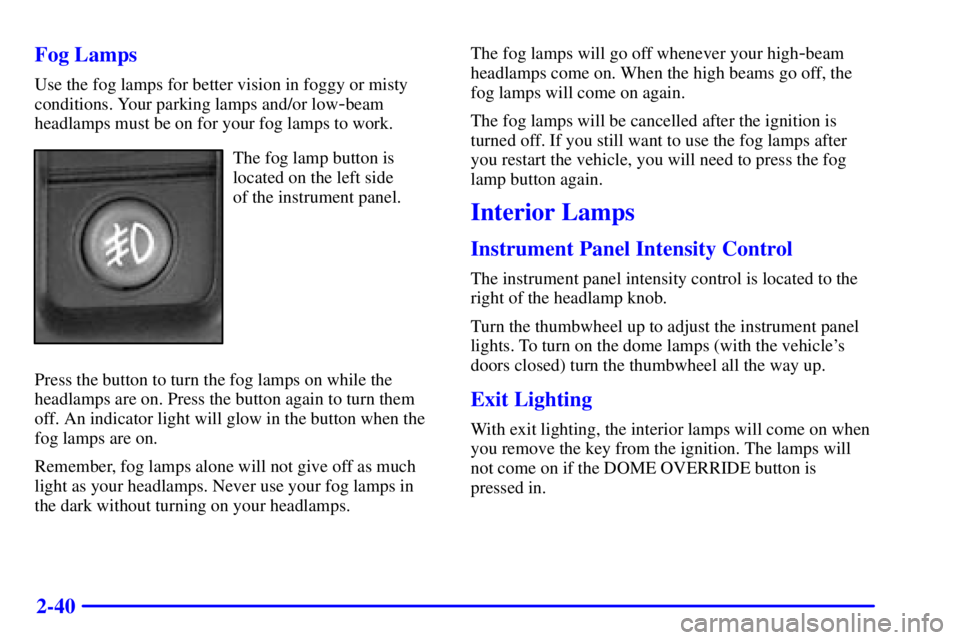Page 121 of 394
2-34 Cruise Control
With cruise control, you can
maintain a speed of about
25 mph (40 km/h) or more
without keeping your foot
on the accelerator. This can
really help on long trips.
Cruise control does not
work at speeds below about
25 mph (40 km/h).
If you apply your brakes, the cruise control
will disengage.CAUTION:
�Cruise control can be dangerous where you
can't drive safely at a steady speed. So,
don't use your cruise control on winding
roads or in heavy traffic.
�Cruise control can be dangerous on
slippery roads. On such roads, fast changes
in tire traction can cause needless wheel
spinning, and you could lose control. Don't
use cruise control on slippery roads.
Page 125 of 394

2-38
There is a delay in the transition between the daytime
and nighttime operation of the Daytime Running Lamps
(DRL) and the automatic headlamp systems so that
driving under bridges or bright overhead street lights
does not affect the system. The DRL and automatic
headlamp system will only be affected when the light
sensor sees a change in lighting lasting longer than
the delay.
To idle your vehicle with the automatic headlamp
system off, set the parking brake while the ignition is
off. Then start your vehicle. The automatic headlamp
system will stay off until you release the parking brake.
As with any vehicle, you should turn on the regular
headlamp system when you need it.
You may be able to turn off your automatic headlamp
system. See ªDaytime Running Lamps (DRL)º later in
this section for more information.
Lamps On Reminder
A reminder chime will sound when your headlamps or
parking lamps are manually turned on and your ignition
is in OFF, LOCK or ACCESSORY. To disable the
chime, turn the thumbwheel all the way down. In the
automatic mode, the headlamps turn off once the
ignition key is in OFF.
Puddle Lamps
Your vehicle is equipped with puddle lamps to help you
see the area near the base of the front doors when it is
dark out. The puddle lamps will illuminate when a door
is opened or when you press the UNLOCK button on the
keyless entry transmitter. The lamps will time out or
turn off once the engine is started.
You can program the puddle lamps not to come on if
you choose. See ªSecondary Information Centerº in the
Index for more information.
Daytime Running Lamps
Daytime Running Lamps (DRL) can make it easier for
others to see the front of your vehicle during the day.
DRL can be helpful in many different driving
conditions, but they can be especially helpful in the
short periods after dawn and before sunset. Fully
functional daytime running lamps are required on all
vehicles first sold in Canada.
The DRL system will come on when:
�the ignition is on,
�the headlamp knob is in automatic headlamp mode,
�the automatic transmission is not in PARK (P),
�the light sensor determines it is daytime and
�the parking brake is released.
Page 127 of 394

2-40 Fog Lamps
Use the fog lamps for better vision in foggy or misty
conditions. Your parking lamps and/or low
-beam
headlamps must be on for your fog lamps to work.
The fog lamp button is
located on the left side
of the instrument panel.
Press the button to turn the fog lamps on while the
headlamps are on. Press the button again to turn them
off. An indicator light will glow in the button when the
fog lamps are on.
Remember, fog lamps alone will not give off as much
light as your headlamps. Never use your fog lamps in
the dark without turning on your headlamps.The fog lamps will go off whenever your high
-beam
headlamps come on. When the high beams go off, the
fog lamps will come on again.
The fog lamps will be cancelled after the ignition is
turned off. If you still want to use the fog lamps after
you restart the vehicle, you will need to press the fog
lamp button again.
Interior Lamps
Instrument Panel Intensity Control
The instrument panel intensity control is located to the
right of the headlamp knob.
Turn the thumbwheel up to adjust the instrument panel
lights. To turn on the dome lamps (with the vehicle's
doors closed) turn the thumbwheel all the way up.
Exit Lighting
With exit lighting, the interior lamps will come on when
you remove the key from the ignition. The lamps will
not come on if the DOME OVERRIDE button is
pressed in.
Page 129 of 394

2-42 Dome Lamps
The dome lamps will come on when you open a door
and will slowly dim to off when all doors are closed.
You can also turn the dome lamps on by turning the
thumbwheel, located next to the parking/headlamps
knob, all the way up. In this position, the dome lamps
will remain on whether a door is opened or closed.
You can use the DOME OVERRIDE button, located
below the parking/headlamp knob, to set the dome
lamps to come on automatically when a door is opened,
or remain off. To turn the lamps off, press the button
into the ªinº position. With the button in this position,
the dome lamps will remain off when the doors are
open. To return the lamps to automatic operation, press
the button again and return it to the ªoutº position. With
the button in this position, the dome lamps will come on
when you open a door.
Battery Run-Down Protection
This feature shuts off the dome, reading, glove box
and underhood lamps if they are left on for more than
20 minutes when the ignition is off. This will keep your
battery from running down.
Mirrors
Electrochromic Inside Rearview Mirror
with Compass and Temperature Display
When on, an electrochromic mirror automatically dims
to the proper level to minimize glare from lights behind
you after dark.
The mirror also includes a display of both the compass
and the temperature in the upper right corner of the
mirror face. The dual display can be turned on or off by
briefly pressing either the TEMP or COMP button.
Page 138 of 394

2-51
To prevent damage or loss of cargo as you're leaving,
check now and then to make sure the luggage and cargo
are still securely fastened.
Be sure the cargo is properly loaded.
�If small heavy objects are placed on the roof, place
the load in the area over the rear wheels (behind the
rear side door on Denali XL models). If you need to,
cut a piece of 3/8 inch plywood to fit inside the
crossrails and siderails to spread the load. If plywood
is used, tie it to the siderail supports.
�Tie the load to the crossrails or the siderail supports.
Use the crossrails only to keep the load from sliding.
To move the crossrails, pull out on the latch release
handle at each end. Slide the crossrail to the desired
position balancing the force side to side. Push the
release handle back into the latched position and
slide the crossrail back and forth slightly to be sure
the latch snaps securely into place.�If you need to carry long items, move the crossrails
as far apart as they will go. Tie the load to the
crossrails and the siderails or siderail supports. Also
tie the load to the bumpers. Do not tie the load so
tightly that the crossrails or siderails are damaged.
�For the purpose of wind noise reduction, locate the
front crossrail approximately 18 to 24 inches
(46 cm to 58 cm) rearward of the front supports.
�After moving a crossrail, be sure it is securely locked
into the siderail.
Your vehicle has a Center High
-Mounted Stoplamp
(CHMSL) located above the rear glass.
If items are loaded on the roof of the vehicle,
care should be taken not to block or damage the
CHMSL unit.
Page 141 of 394

2-54
OnStar Services Button: Press this button once to
contact an advisor who will be able to assist you with
these services. If you are not quickly connected, the
system will automatically reset and redial. This ensures
connection to the center; there is no additional action
required. Press the Call Answer/End button to cancel the
automatic redial.
Emergency Button: In an emergency situation,
press the emergency service button. Upon receiving the
call, an advisor at the center will locate your vehicle and
assess the situation. If necessary, the advisor will alert
the nearest emergency service provider.
Call ANSWER/END Button: Use this button
to answer a call. (If you are receiving a call, the audio
system will mute, and the ring will be heard). Press this
button at the end of a call to disconnect and return the
audio system to its previous settings. This button will
also cancel a call if one of the buttons is accidentally
pressed or if the automatic redial function is activated.Volume Control: You can control the volume of the
OnStar System using either the volume control knob
on the radio or using the steering wheel controls,
if equipped.
Telltale Light: This light will indicate the status of
the system. A solid green light will come on when you
start the vehicle to let you know that the system is on
and is ready to make or receive calls.
If the light blinks green it means that an incoming or
outgoing call is in progress. Press the Call
ANSWER/END button if you notice the light blinking
and you are not on a call.
The light will be red in the event of an OnStar system
malfunction. If this occurs press the OnStar button to
attempt to contact an advisor. If the connection is made,
the advisor will assist you with steps to take to make
sure that the system is functioning properly. If you
cannot contact the advisor, take your vehicle to your
dealership as soon as possible for assistance.
Page 150 of 394
2-63
The main components of your instrument panel are the following:
A. Dome Lamp Override Switch
B. Lamp Controls
C. Air Outlets
D. Storage Compartment
E. Multifunction Lever
F. Instrument Panel Cluster
G. Shift Lever
H. Tow/Haul Switch
I. Audio System
J. Comfort Control System
K. Instrument Panel Fuse BlockL. Hood Release
M. Audio Steering Wheel Controls
N. Center Instrument Panel Utility Block
O. Tilt Lever
P. Parking Brake Release
Q. Secondary Information Center (SIC)
R. Rear Window Defogger Switch
S. Compact Disc Changer
T. Ashtray
U. Accessory Power Outlet
V. Glovebox
Page 176 of 394
3-
3-1
Section 3 Comfort Controls and Audio Systems
In this section, you'll find out how to operate the comfort control and audio systems offered with your vehicle.
Be sure to read about the particular systems supplied with your vehicle.
3
-2 Comfort Controls
3
-2 Electronic Climate Control System
3
-8 Air Conditioning
3
-8 Heating
3
-9 Defogging and Defrosting
3
-9 Rear Window Defogger
3
-10 Ventilation System
3
-11 Audio Systems
3
-11 Setting the Clock
3
-11 AM-FM Stereo with Cassette Tape Player3
-16 Rear Seat Audio (RSA)
3
-18 Compact Disc Changer
3
-21 Theft-Deterrent Feature
3
-23 Audio Steering Wheel Control
3
-24 Understanding Radio Reception
3
-24 Tips About Your Audio System
3
-25 Care of Your Cassette Tape Player
3
-26 Care of Your Compact Discs
3
-26 Care of Your Compact Disc Changer
3
-26 Fixed Mast Antenna